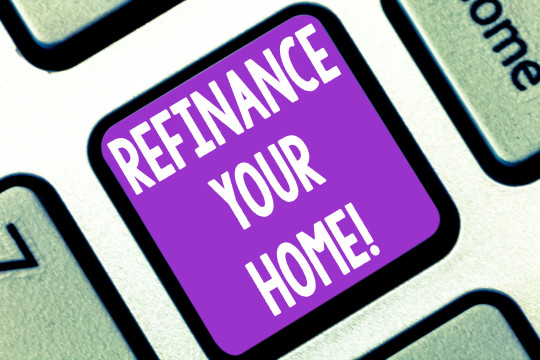Text
Mortgage Refinance - What You Should Know Before Refinancing Your Mortgage

Taking out a mortgage refinance is a great way to lower your monthly payments and interest rate. However, there are some things you should consider before doing so.
You should consider your credit score, how much your monthly payments are, and what your long-term goals are before you take out a mortgage refinance. A lower interest rate can save you hundreds of dollars in the long run. If you don't know if you can qualify for a refinance, you should work with a financial planner.
You should also consider whether you have enough equity in your home to qualify for a mortgage refinancing. If you have equity in your home, you can use it to pay off credit cards or for major expenses. If you don't have enough equity to cover your loan, you may want to consider a home equity line of credit instead. This loan is calculated by subtracting the balance of your original mortgage from your home's value. A cash-out refinance can be a great way to pay for a home improvement project, a child's tuition, or even to purchase a vacation property.
When you're considering a mortgage refinance, you should shop around to get the best rates. You should also view the number of closing costs that you'll have to pay. These costs may range from 2 percent to 5 percent of the amount you refinance. You can find out exactly what these costs are before you begin your search.
If you decide to refinance your mortgage, you'll need to pay for an appraisal. You'll also need to pay application fees and title search fees. In addition, you'll have to wait at least six months after you take out your loan to start your refinance.
Depending on the circumstances, a mortgage refinances may be your best financial decision. However, you should be aware that it's possible for it to negatively affect your credit. You'll have to undergo a credit check, and your credit score may take a temporary hit. A single inquiry can lower your credit score by as much as five points.
Mortgage refinancing can also lead to increased debt. If you're refinancing to a 30-year mortgage, you may have a higher interest rate than you were originally able to afford. If you aren't sure if you can qualify for a mortgage refinance, you can use a mortgage refinance calculator to find out. You can also get a personalized refinance quote from a lender.
If you are considering a second mortgage, you may want to look for a lender that offers customer credit. This is a type of credit that's given to existing customers of a particular lender. If you qualify for the credit, it will be deducted from your closing costs. In addition, you may be able to qualify for a lower interest rate if your credit score is higher than it was when you first took out the loan. Explore more on this subject by clicking here: https://en.wikipedia.org/wiki/Refinancing.
0 notes
Text
The Basics of a Reverse Mortgage

Obtaining a reverse mortgage is a viable option for aging homeowners to receive additional income to help maintain a higher quality of life. If you are considering this type of loan, it is advisable to consult an independent financial adviser. Reverse mortgages can be received as either a lump sum or as a line of credit. Generally speaking, the amount owed on a reverse mortgage can never exceed the value of the home. However, if the value of the home decreases significantly, it may be necessary to sell the home to pay back the loan.
A retired mortgage premium is an initial one-time charge, and it protects the lender. This one-time fee is equal to two percent of the loan amount. However, this fee is not deductible until it is paid. Also, there may be monthly service charges. A service charge is a fee the lender charges for bringing the loan up to date. These fees are typically around $30 a month.
A reverse mortgage is a type of home loan available to homeowners who are at least 62 years old. To qualify for this type of loan, the borrower must own the home outright and have sufficient equity in the property. This equity is used as collateral. Homeowners also must maintain their home and homeowners insurance. Depending on the type of reverse mortgage, there may be other conditions imposed on the borrower.
In most cases, the borrower must live in the home. This means that a reverse mortgage is not a good option for people who want to leave the home to their children. In some cases, the borrower may be required to live in the home for a minimum number of years. If the home is left unoccupied for more than 12 months, the loan becomes due and payable.
The most common type of reverse mortgage is the HECM (Home Equity Conversion Mortgage). HECMs are only offered by federally approved lenders. The Federal Housing Administration insures the HECM program. This program is designed to protect lenders and borrowers and limits the amount of money a borrower can receive. The amount available under the HECM program is based on the age of the borrower, the amount of the home's appraised value, and the expected interest rate.
The HECM is a good option if you need to move to a new home, or if you want to downsize. If you have a large amount of equity in your current home, you may consider obtaining a reverse mortgage to help you get started in your new location. The money you receive through this type of loan may also help you pay for medical or other living expenses. A reverse mortgage may also be a good option if you are considering selling your home. Visit the Mortgage Maestro webpage to learn more on home refinancing.
If you are considering obtaining a reverse mortgage, you may also want to consider getting an unsecured personal loan. These are typically unsecured loans that require monthly payments, but they can provide a lump sum of cash. The interest rates for unsecured personal loans are generally lower than those of reverse mortgages. To familiarize yourself more with this topic, it is best that you check out this post: https://simple.wikipedia.org/wiki/Refinancing.
0 notes
Text
What Is a Mortgage Refinance?

Generally speaking, a mortgage refinance is a way to lower your interest rate, thereby lowering your monthly mortgage payment. In the process, you will have the opportunity to customize your loan's terms and features. You may also have the opportunity to access your home's equity. This can be useful for various purposes, including financing major expenses.
A mortgage refinances calculator can be a useful tool in determining the best refinance for you. This calculator can help you compare the many features and options available to you. You may even be able to save money by shopping around. In addition to comparing lenders' offers and fees, you may want to consider the amount of equity you have in your home. The more equity you have, the lower your interest rate will be.
In addition to lowering your monthly payments, the Ontario mortgage firm will also allow you to extend the life of your loan. For instance, if you have three years left on a 30-year mortgage, you can request your lender to make your payments over 27 years. This could save you thousands of dollars in interest over the life of your loan.
While a mortgage refinances is not without its pitfalls, it can be a smart move if you are in a position to take advantage of it. However, if you do not make the right choice, refinancing can worsen your debt problem. It can also create a cycle of increased interest payments that will eventually lead to bankruptcy. In addition, it can be a risky move for borrowers with an adjustable-rate mortgage.
If you are self-employed, your mortgage lender may require additional documentation regarding your income and assets. In addition, you may need to provide proof that you reside in the U.S. Your spouse may also be required to provide documentation regarding their income. You should also be aware that many mortgage lenders do not require a new home appraisal.
If you can qualify for a mortgage refinance, you should shop around for a better deal. This is particularly true if you plan to move shortly. Using a calculator to determine the break-even point can help you decide whether or not refinancing is worth the cost.
The mortgage refinancing process works the same way as the process of buying a home. When you apply for a mortgage, you are evaluated by the lender based on your income, assets, and debt. You may also be asked to provide information related to the transfer of your home.
You may not be able to take advantage of a mortgage refinance if you have a low credit score, limited equity in your home, or have other financial problems. If this is the case, it may be best to consult a financial planner before you refinance your mortgage. A financial planner can help you identify the best mortgage refinance options for you.
Although you may not be able to take advantage of all of the features available to you, a mortgage refinances calculator can be a great tool to help you determine which mortgage options will work best for you. This calculator can also help you figure out which mortgages are the most cost-effective. Check out this post for more details related to this article: https://en.wikipedia.org/wiki/Remortgage.
1 note
·
View note